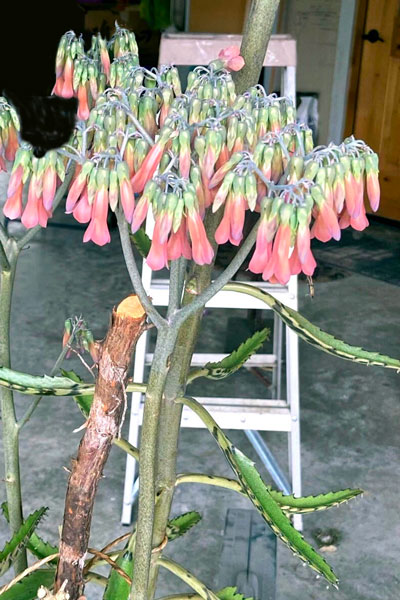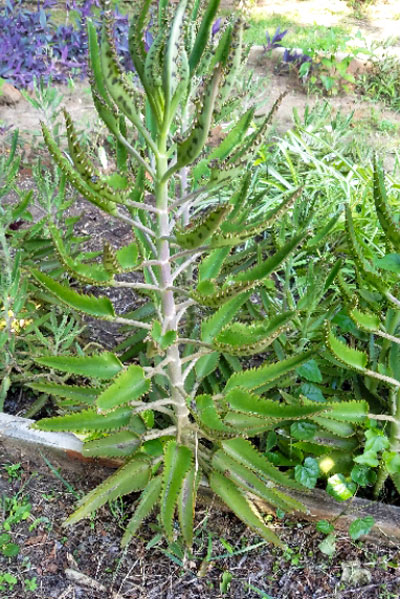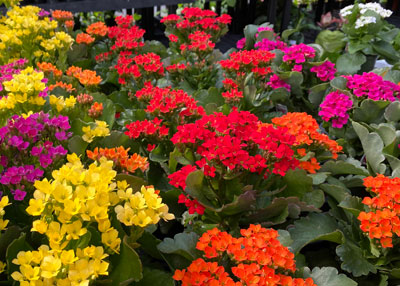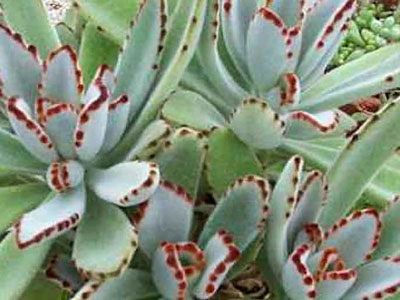Kalanchoe of a Different Sort

That “friend” who sent this photo for ID was actually Carolyn Skei. She was also the editor of my latest book, Lone Star Gardening. I’d really refer to her more in the category of “dear friend, incredible editor and accomplished gardener.” Knowing she was an avid gardener, one of Carolyn’s friends had sent her this photo asking her help in identifying the plant.
Carolyn said she hadn’t ever seen a blooming plant like this. That’s because these plants have to get some age to them to produce flowers, and by then folks have usually trimmed them way back or given them away. Kinda like you give away all that sourdough starter that’s blowing the doors off the fridge. You get a lot more than you want.
But to get to my story…
This plant is botanically Kalanchoe daigremontiana. Those who don’t care to use that name in their everyday chat might opt instead for “mother of thousands” or “mother of millions.” (I’ll explain those in a moment.) Other common names include “alligator plant,” referring to the leaves’ resemblance to a ‘gator with its mouth wide open and ready to snap.
And now to the punch line…
This plant has the knack of producing little plantlets all along its leaf margins, one at every inlet of the wavy edge. Scores per leaf. Hundreds per stem. Thousands per plant. Soon, millions per collector.
These little plantlets drop off the leaves with the slightest movement – say, when you’re watering, or when you’re moving a pot, or when you sneeze two rooms away.

Next thing you know, they’re all over the ground. And all over the pots that are sitting next to your plant.
All of which isn’t too bad, because they’re cute little plants, generally easy to remove where they’re not wanted, and favorites to give to young gardeners who love the whole process.
But…
If you also collect cacti (as I do), you soon learn not to put this succulent plant anywhere near them. It’s just no fun at all to pull little mothers of thousands (almost sounds like I’m swearing) out of a pot filled with a cactus. That’s why they invented really long tweezers that let you stand way back to pluck.

What you need to know to grow it…
I’ve wasted enough of your time. Here are the real facts.
• It’s a succulent. Grow it in a well-draining potting soil.
• Bright light. That’s full sun in the winter and morning sun in the summer.
• Clay pots work best because they’re heavier. This plant gets heavy when it gets tall, especially if it blooms (note the heavy staking in the photo).
• Keep it moist for best growth, but never wet for prolonged periods.
• Fertilize it monthly with a diluted, water-soluble, high-nitrogen fertilizer.
• It won’t handle freezing weather, so make provision to get it indoors during winter. Greenhouse or bright window.
• You will notice several different leaf shapes. Those are different species, but at that point I’ll turn you over to the serious plant taxonomists. My work here is done.
And here is the sister that you know so much better…
Those beautiful florist kalachoes are in the same genus.

While they may not produce the tiny plantlets around their leaf margins, they’re easily propagated from small stem cuttings. I’ve even seen people root leaf cuttings and have plantlets develop in the propagation bed.

The genus Kalanchoe is a fascinating group of beautiful plants. Most are grown for their diverse foliage. Give them a try!
